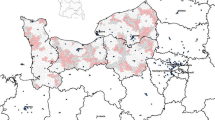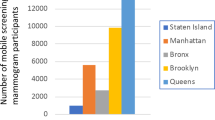Abstract
Background
The aims of this study were to evaluate the contribution of mobile mammography units to participation rate and to compare their performance to fixed screening centres within the organized mammography screening program of Quebec, Canada.
Methods
The study is based on all screening mammograms carried out in women aged 50–69 who participated in the Québec program from 2002 to 2010. Performance was measured by screening sensitivity, false-positive rate (1-specificity), positive likelihood ratio as well as abnormal call rate, detection rate, interval cancer rate, positive predictive value, and tumour characteristics. Poisson regression models with robust variance estimation were used to take into account the multi-level structure of the data. All models were adjusted for characteristics related to women.
Results
During the 2002–2010 period, 2,292,592 screening mammograms were performed, of which 42,279 (1.8%) were in mobile units. In regions serviced exclusively by mobile units, the participation rate reached an average of 63.4% during the 2006–2010 period compared to 54.7% for the entire study population. Estimated sensitivity was similar to that of fixed sites (rate ratio = 0.98 [0.84–1.15]) while the false-positive rate was lower (rate ratio = 0.76 [0.57–1.02]) although this difference was of marginal statistical significance (p=0.07).
Conclusions
In this program, mobile mammography units allowed regions lacking a fixed centre to attain participation rates slightly higher than those in the rest of Quebec, without loss of sensitivity and with some gain in the false-positive rate.
Résumé
Contexte
Les objectifs de cette étude sont d’évaluer la contribution des unités mobiles en mammographie du Programme québécois de dépistage du cancer du sein sur le taux de participation du programme ainsi que de comparer leur performance à celle des centres fixes.
Méthodes
L’étude est basée sur toutes les mammographies de dépistage réalisées chez des femmes de 50 à 69 ans pour la période 2002 à 2010. La performance des unités mobiles est évaluée à partir de la sensibilité, du taux de faux positif (1-spécificité), du ratio de vraisemblance, du taux de référence pour anomalie, du taux de détection, du taux de cancer d’intervalle, de la valeur prédictive positive et des caractéristiques des cancers. Un modèle de régression de Poisson avec estimation robuste de la variance a été utilisé afin de prendre en compte la structure multiniveaux des données. Les modèles sont ajustés pour les caractéristiques des femmes.
Résultats
Pour la période 2002 à 2010, 2 292 592 mammographies de dépistage ont été réalisées, dont 42 279 (1,8 %) en unités mobiles. Dans les régions desservies uniquement par les unités mobiles, le taux de participation atteint une moyenne de 63,4 % pour la période 2006 à 2010 comparativement à 54,7 % pour l’ensemble de la cohorte à l’étude. La sensibilité était similaire à celle des centres fixes (rapport de risque = 0,98 [0,84–1,15]) tandis que le taux de faux positif était plus faible (rapport de risque = 0,76 [0,57–1,02]), quoique presque statistiquement significatif (p=0,07).
Conclusions
Dans ce programme, les unités mobiles de mammographie permettent aux régions dépourvues de centres fixes d’atteindre un taux de participation légèrement plus élevé que dans le reste du Québec, et ce avec une sensibilité équivalente et un certain gain dans le taux de faux positifs.
Similar content being viewed by others
References
Gotzsche PC, Nielsen M. Screening for breast cancer with mammography. Cochrane Database Syst Rev 2006;(4):CD001877.
Humphrey LL, Helfand M, Chan BK, Woolf SH. Breast cancer screening: A summary of the evidence for the U.S. Preventive Services Task Force. Ann Intern Med 2002;137(5 Part 1):347–60.
Ministère de la santé et des services sociaux. Programme Québécois de Dépistage du Cancer du Sein (PQDCS). Cadre de référence. Gouvernement du Québec, 1996.
Donabedian A. Aspects of Medical Care Administration: Specifying Requirements for Health Care. Cambridge, UK: Harvard University Press for the Commonwealth Fund, 1973.
Legler J, Meissner HI, Coyne C, Breen N, Chollette V, Rimer BK. The effectiveness of interventions to promote mammography among women with historically lower rates of screening. Cancer Epidemiol Biomarkers Prev 2002;11(1):59–71.
Reuben DB, Bassett LW, Hirsch SH, Jackson CA, Bastani R. A randomized clinical trial to assess the benefit of offering on-site mobile mammography in addition to health education for older women. AJR Am J Roentgenol 2002;179(6):1509–14.
Health Technology Inquiry Service. Portable and Mobile Mammography Screening Services. 2007.
Massin-Short SB, Grullón MA, Judge CM, Ruderman KR, Grullón M, Lora V. A mobile mammography pilot project to increase screening among Latina women of low socioeconomic status. Public Health Rep 2010;125:765–71.
Vyas A, Madhavan S, LeMasters T, Atkins E, Gainor S, Kennedy S, et al. Factors influencing adherence to mammography screening guidelines in Appalachian women participating in a mobile mammography program. J Community Health 2012;37:632–46.
Naeim A, Keeler E, Bassett LW, Parikh J, Bastani R, Reuben DB. Costeffectiveness of increasing access to mammography through mobile mammography for older women. J Am Geriatr Soc 2009;57(2):285–90.
Brown ML, Fintor L. U.S. screening mammography services with mobile units: Results from the National Survey of Mammography Facilities. Radiology 1995;195(2):529–32.
Daures JP, Berthaud G, Stoebner A, Arnaud C, Lamarque JL, Laurent JC, et al. Diagnosis of cancer of the breast by mammography screening in a mobile van: The 5,000 first results of the Herault experience. Pathol Biol (Paris) 1992;39(9):853–54.
Séguret F, Daures JP, Guizard AV, Mathieu-Daude H, Bonifacj JC, Cherifcheik J, Lamarque JL. Herault breast screening programme: Results after 30 months of a mobile French schedule. Eur J Cancer Prev 1995;4(4):299–305.
Kann PE, Bradley C, Lane DS. Outcomes of recommendations for breast biopsies in women receiving mammograms from a county health van. Public Health Rep 1998;113(1):71–74.
Collège des médecins du Québec. Annuaire médical 2002–2006. 1998.
Théberge I, Langlois A, Major D, Langlois A, Brisson J. Validation de stratégies pour obtenir le taux de détection du cancer, la valeur prédictive positive, la proportion de cancers in situ, la proportion de cancers infiltrants de petite taille et la proportion de cancers infiltrants sans envahissement ganglionnaire dans le cadre des données fournies par le Programme québécois de dépistage du cancer du sein (PQDCS). Québec: Institut national de santé publique du Québec, 2003.
Zeger SL, Liang KY. Longitudinal data analysis for discrete and continuous outcomes. Biometrics 1986;42(1):121–30.
Ichikawa LE, Barlow WE, Anderson ML, Taplin SH, Geller BM, Brenner RJ, et al. Time trends in radiologists’ interpretive performance at screening mammography from the community-based Breast Cancer Surveillance Consortium, 1996–2004. Radiology 2010;256(1):74–82.
Miglioretti DL, Heagerty PJ. Marginal modeling of nonnested multilevel data using standard software. Am J Epidemiol 2007;165(4):453–63.
Morestin F, Gauvin FP, Hogue MC, François B. Méthode de synthèse de connaissances sur les politiques publiques. Montréal: Centre de collaboration nationale sur les politiques publiques et la santé, 2010.
Marrett LD, Chaudhry M. Cancer incidence and mortality in Ontario First Nations, 1968–1991 (Canada). Cancer Causes Control 2003;14(3):259–68.
O’Malley AS, Lawrence W, Liang W, Yabroff R, Lynn J, Kerner J, Mandelblatt J. Feasibility of mobile cancer screening and prevention. J Health Care Poor Underserved 2002;13(3):298–319.
Schweitzer ME, French MT, Ullmann SG, McCoy CB. Cost-effectiveness of detecting breast cancer in lower socioeconomic status African American and Hispanic women through mobile mammography services. Med Care Res Rev 1998;55(1):99–115.
Clarke PM. Cost-benefit analysis and mammographic screening: A travel cost approach. J Health Econ 1998;17(6):767–87.
Author information
Authors and Affiliations
Corresponding author
Additional information
Conflict of Interest: None to declare.
Rights and permissions
About this article
Cite this article
Fontenoy, AM., Langlois, A., Chang, SL. et al. Contribution and Performance of Mobile Units in an Organized Mammography Screening Program. Can J Public Health 104, e193–e199 (2013). https://doi.org/10.17269/cjph.104.3810
Received:
Accepted:
Published:
Issue Date:
DOI: https://doi.org/10.17269/cjph.104.3810




